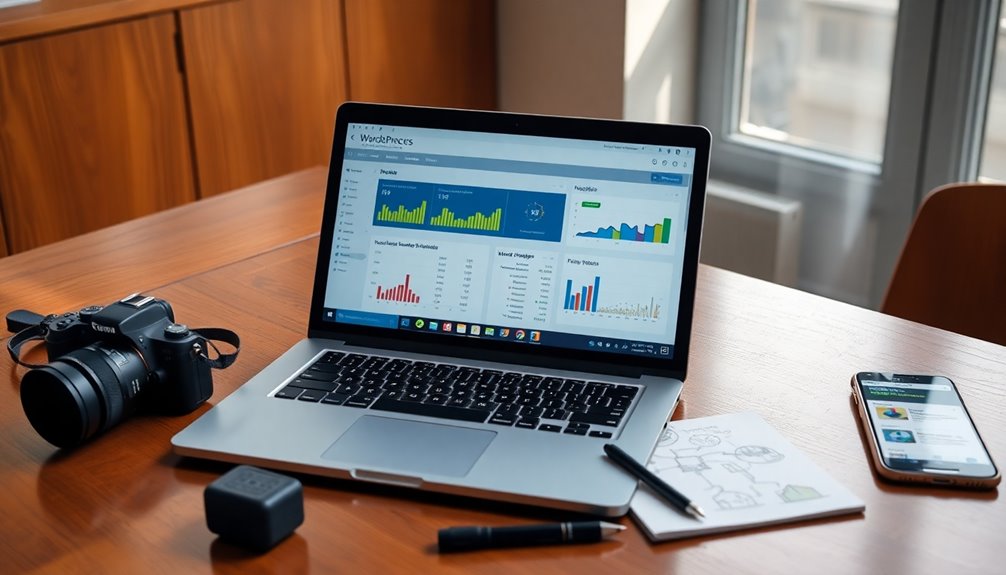To maximize your website's potential with WordPress tools, focus on performance optimization, user experience, and SEO strategies. Use caching plugins like WP Rocket to speed up your site, as even a second delay can hurt sales. Choose responsive themes for mobile users, and enhance your visibility with SEO plugins like Yoast SEO. Don't forget about security; tools like Wordfence keep your site safe. Regular updates and backups are essential to prevent issues. By effectively leveraging these tools and strategies, you'll set your site up for success—there's plenty more to explore for enhancing your WordPress experience.
Benefits of WordPress Tools

When it comes to enhancing your website, WordPress tools can be a game-changer. These tools offer numerous benefits that help you improve your site's performance, security, and overall user experience.
For instance, performance optimization tools like WP Rocket and W3 Total Cache can drastically reduce page load times. A faster site not only keeps visitors engaged but also boosts conversions, as studies show that even a 1-second delay can lead to a 7% loss in sales.
Using an SEO plugin like Yoast SEO or Rank Math can further elevate your site's visibility. These plugins optimize your content with metadata and keyword suggestions, helping improve your search engine rankings. Additionally, implementing keyword research and optimization can significantly enhance your content's relevance and visibility.
If you're running an e-commerce site, tools like WooCommerce can transform your WordPress site into a fully functional online store, catering to a vast market of online shoppers.
Lastly, don't overlook the importance of security plugins such as Wordfence and Sucuri. They protect your site from vulnerabilities, offering features like real-time monitoring and malware scanning.
Selecting the Perfect Theme
When you're selecting a theme, focus on how well it aligns with your brand identity.
Make sure it's responsive for mobile users, since a significant portion of web traffic comes from mobile devices. A theme like OceanWP can enhance your site's performance with its lightweight design and compatibility with popular page builders. Additionally, consider a theme like Astra, known for its fast-loading performance and user-friendly interface.
Also, look for customization options that let you create a unique experience for your visitors.
Consider choosing a theme with extensive customization options to ensure your website stands out from the competition.
Aligning Brand Identity
Choosing the right theme for your WordPress site is essential for aligning your brand identity. A visually appealing theme can make a significant impact, as 93% of users consider visual appearance the key factor in their first impression.
By selecting themes that resonate with your brand, you'll enhance user engagement and create a memorable experience.
Look for themes that offer robust customization options. Tailoring colors, fonts, and layouts allows you to maintain brand consistency across your online presence.
Keep in mind that unique and well-designed themes can lead to a 200% increase in conversion rates compared to average designs.
Make certain to choose themes and plugins that are regularly updated and come with positive reviews. This not only guarantees better performance but also boosts security, which is critical for maintaining user trust.
Mobile Responsiveness Importance
Understanding the importance of mobile responsiveness is vital for any WordPress site. With over 50% of global web traffic coming from mobile devices, you need a responsive theme to guarantee a seamless user experience across all screen sizes.
If your site isn't mobile-friendly, you're likely to see higher bounce rates, as users will quickly leave if they can't navigate easily on their devices.
Google prioritizes mobile-friendly websites in its search rankings, meaning that a responsive theme can greatly enhance your site's visibility and organic traffic. This visibility is essential for attracting more visitors and improving user satisfaction.
When users have a consistent experience across their devices, they're more likely to trust your brand and engage with your content.
Responsive themes typically incorporate fluid grids and flexible images that adapt to different screen sizes. This not only enhances usability but also boosts engagement, as users can easily interact with your site regardless of the device they're using.
Ultimately, selecting the right responsive theme is key to maximizing your website's potential and guaranteeing that visitors have a positive experience.
Customization Options Available
Selecting the perfect WordPress theme involves considering several customization options that can elevate your site's appeal and functionality.
First and foremost, prioritize a theme with responsive design so your site looks great on any device. With over 50% of web traffic coming from mobile users, this feature is essential for enhancing user experience.
Next, choose themes from reputable sources that offer a variety of customization options, like color schemes, typography, and layouts. This flexibility helps align the theme with your brand identity.
Make certain the theme you select is regularly updated and compatible with the latest version of WordPress to guarantee security and peak site performance.
Additionally, look for themes that come with built-in SEO features or are compatible with popular SEO plugins. A well-optimized theme can greatly improve your search engine rankings.
Before making a decision, utilize demo versions to assess load speed and overall performance. Poor-performing themes can lead to increased bounce rates, negatively affecting user engagement.
Customizing Your WordPress Design

In today's digital landscape, customizing your WordPress design is vital for creating a standout online presence. Choosing a responsive theme is important since over 52% of global website traffic comes from mobile devices. This guarantees a seamless experience across all screen sizes, which helps enhance user interaction. Regularly updating your themes ensures that your site remains compatible with the current WordPress version, which is crucial for optimal performance. Additionally, implementing a regular backup strategy protects your site from data loss during the customization process.
With thousands of customizable WordPress themes available, you can easily select a design that aligns with your brand identity and appeals to your target audience. Utilizing plugins like Elementor allows you to enjoy design flexibility, letting you create unique layouts without needing coding knowledge. This drag-and-drop interface simplifies the customization process, making it accessible for everyone.
Don't forget to incorporate elements like logos, unique headers, and custom fonts. These features can greatly improve your brand recognition and keep visitors engaged with your site. Additionally, using a child theme ensures that your customizations remain intact even after updates to the parent theme.
Regularly updating your themes and plugins not only enhances your design but also guarantees compatibility with the latest WordPress features, ultimately improving your site's performance and security. Implementing a backup strategy before theme installation helps safeguard your content and allows for a smooth transition during updates.
Crafting Engaging Content
To craft engaging content, you need to understand your audience's preferences and needs.
By incorporating visual content strategies, like images and videos, you can capture attention quickly and keep visitors interested. Additionally, using high-quality content is crucial for retaining visitor attention and boosting engagement. Structuring your posts for readability won't only enhance user experience but also encourage them to stick around longer. Furthermore, leveraging SEO optimization techniques can help your content reach a wider audience, increasing overall engagement. Additionally, high-quality media can significantly increase user engagement by captivating audiences with appealing visuals.
Audience Understanding Techniques
Understanding your audience is essential for crafting engaging content that truly resonates. Start by researching your target audience through surveys and social media insights. This will reveal their preferences and pain points, allowing you to tailor content effectively.
Utilizing tools like Google Analytics can track user interactions on your site, providing valuable data on which content is most engaging and where visitors drop off.
Creating personas based on demographic and psychographic data can guide your content creation, ensuring it meets the specific needs of different audience segments. Engaging directly with your audience through comments, emails, and social media offers immediate feedback, helping you refine your content strategy further.
Additionally, analyzing competitors' content performance with tools like SEMrush can provide insights into successful topics and formats. This not only helps you understand what works but also enables you to create content that stands out and captures your audience's attention.
Visual Content Strategies
Visual content strategies are vital for creating engaging websites that capture and hold visitors' attention. By incorporating high-quality images, videos, and infographics, you can boost user engagement by up to 94%. This makes your site not just more appealing but also more informative.
Remember, people retain just 10% of information without visuals, but with relevant images, that jumps to 65%.
To maximize impact, optimize images by using the right file sizes and alt tags, improving your page load speed. Since 40% of users abandon sites that take longer than three seconds to load, this step is important.
Additionally, infographics are shared three times more than other content types on social media, which can greatly expand your audience reach and enhance brand visibility.
Effective visual content can also lead to a 37% increase in conversion rates. When visitors encounter engaging visuals that complement your content, they're more likely to take action.
SEO Techniques for WordPress

While many factors influence your website's visibility in search results, implementing effective SEO techniques for WordPress can make a significant difference. Start by conducting thorough keyword research to identify relevant terms that your audience is searching for. Remember, 75% of users never scroll past the first page, so targeting the right keywords is essential.
Next, optimize your on-page elements using plugins like Yoast SEO or Rank Math. These tools help you craft compelling meta descriptions, improve keyword density, and enhance readability scores. Regularly updating your plugins and utilizing caching tools can further improve loading speeds and overall site performance. Additionally, selecting a SEO-friendly theme can provide a solid foundation for your optimization efforts.
Moreover, implementing structured data with tools like Schema Pro allows search engines to better understand your content, which can lead to valuable rich snippets and boost your click-through rates by up to 30%.
Don't overlook the importance of internal linking. A well-defined linking structure not only improves navigation but also distributes page authority across your site, potentially increasing your organic traffic by 40%.
Regularly updating your content and optimizing images with alt tags signals relevance to search engines, helping improve your site's loading speeds—something that can greatly impact your conversions.
Moreover, utilizing the right SEO tools can streamline your optimization efforts and provide ongoing support, ensuring your site remains competitive in search results.
Embrace these SEO techniques to release your website's full potential.
Leveraging Social Media Integration
Harnessing the power of social media integration can greatly amplify your WordPress site's reach and engagement. By integrating social media sharing buttons, you can boost your content's visibility by up to 200%, encouraging users to share your posts across their networks. This simple addition can lead to a significant increase in traffic back to your site.
Utilizing plugins like Social Snap allows for auto-posting to multiple social platforms, enhancing engagement and driving more visitors your way. Additionally, implementing WordPress backup plugins is vital for safeguarding your site against data loss, ensuring that your content is protected as it reaches a wider audience.
Additionally, displaying social media feeds directly on your site can improve user trust, as 79% of consumers say user-generated content highly impacts their purchasing decisions. Encouraging user-generated content through social media also fosters community interaction; 70% of consumers are more likely to support brands that actively engage with them on these platforms.
Moreover, implementing social proof tools like TrustPulse can leverage real-time notifications of user activity to influence potential customers, increasing conversion rates by up to 15%. Furthermore, incorporating secure backup solutions is essential for protecting your content and ensuring that user-generated data is safely stored.
Monetizing Your WordPress Site

Monetizing your WordPress site can release new revenue streams and turn your passion into profit. One effective method is affiliate marketing, where you promote products and earn commissions on sales.
Top affiliates can make over $50,000 monthly, so it's worth exploring strategic partnerships.
Another lucrative option is selling digital products like eBooks, online courses, or software. With minimal overhead costs, platforms like WooCommerce make transactions seamless.
This allows you to enjoy higher profit margins compared to physical products.
You might also consider offering premium content through membership subscriptions. Charging anywhere from $5 to $50 monthly can create a steady income stream, especially if the value you provide keeps subscribers engaged.
Lastly, don't underestimate the power of email marketing. By promoting your products and services through targeted campaigns, you can greatly boost sales.
Studies show that for every dollar spent on email marketing, the average return on investment is $42.
Essential Site Management Practices
Managing your WordPress site effectively is vital for its success and longevity. One of the most important key site management practices is regularly updating your WordPress core, themes, and plugins. This keeps your site secure and guarantees peak WordPress performance since outdated software can lead to vulnerabilities.
Implementing a reliable backup solution, like UpdraftPlus, protects your content from data loss due to crashes or hacks. It's also important to manage user roles effectively, assigning appropriate permissions to prevent unauthorized access and maintain security.
To further enhance your WordPress sites, incorporate caching plugins such as W3 Total Cache. These plugins greatly reduce server load and improve page delivery speed, ensuring a seamless user experience on high-traffic sites.
Utilizing performance monitoring tools like Google Analytics and Datadog allows you to gain real-time insights into site traffic and resource usage. This proactive approach helps you identify and manage potential issues before they escalate.
Performance Optimization Strategies

To boost your website's performance, it's essential to focus on media optimization and caching mechanisms.
Using plugins like Smush for images and WP Rocket for caching can drastically enhance load times.
These strategies not only improve user experience but also contribute to better search engine rankings.
#
Media Optimization Techniques
When it comes to optimizing your website's media, implementing effective techniques can make a world of difference in performance. Start by compressing images before you upload them. Tools like Smush can help reduce file sizes without sacrificing quality, greatly improving loading times.
Lazy loading is another powerful technique; it guarantees images load only as users scroll down the page, enhancing initial page load speed by up to 50%.
Don't forget about responsive image techniques. Using the "srcset" attribute allows your site to serve different image sizes based on the user's device, which cuts down unnecessary data usage. Regularly compressing existing images in your Media Library can lead to an impressive 50-80% performance improvement in page load times.
Finally, consider integrating a Content Delivery Network (CDN). A CDN boosts media delivery speed by reducing latency, as it serves images from the nearest server location to the user.
Caching Mechanisms Implementation
Implementing caching mechanisms on your WordPress site is crucial for improving performance and enhancing user experience. By utilizing tools like WP Super Cache, you can greatly reduce server load and improve page delivery speeds. This means your visitors get faster access to your content, which can lead to higher retention rates.
Different types of caching mechanisms, such as page, object, and opcode caching, work together to streamline your site's operations. For instance, properly configured caching settings can cut down database queries by storing frequently accessed data, resulting in quicker response times, especially during peak traffic.
Don't forget about browser caching, which allows returning visitors to load pages faster by storing static files locally. This can boost overall site speed by up to 80% for repeat users.
To verify your caching strategies are effective, regularly test and monitor performance using tools like GTmetrix or Google PageSpeed Insights. These tools help you identify any bottlenecks, confirming that your caching mechanisms are truly enhancing site speed and providing an excellent user experience.
Make caching a priority, and watch your site's performance soar!
Load Testing Your Website
Load testing your website is essential for ensuring it performs well under pressure. This process simulates high traffic scenarios, helping you identify bottlenecks and weaknesses in your infrastructure before real users arrive.
To effectively conduct load testing, you'll want to select accurate tools, such as JMeter or LoadRunner, and run tests in a staging environment that mirrors your live site. This way, you avoid disrupting your users.
Key metrics to monitor during load testing include page load times, server response times, and error rates. These metrics provide valuable insights into how your site behaves under varying user loads. By gradually increasing the user load during your tests, you can pinpoint where performance starts to degrade, preparing your site for unexpected traffic spikes.
After analyzing stress test results, such as average and maximum response times, you can identify necessary optimizations to enhance your website performance. Utilizing tools like Google can also help you optimize content, ensuring your site remains fast and responsive even under pressure.
Load testing not only boosts your confidence in your site's capability but also enhances the overall user experience.
Managing High-Traffic Sites

After guaranteeing your website can handle traffic spikes through load testing, the next step is managing high-traffic situations effectively. Upgrading from shared hosting to dedicated or cloud hosting is essential for high-traffic WordPress sites. This guarantees you have adequate resources and minimizes downtime during peak times.
Implementing caching mechanisms using plugins like W3 Total Cache can dramatically reduce server load and enhance page delivery speed, which is fundamental when traffic surges. Additionally, utilizing Content Delivery Networks (CDNs) helps distribute traffic more effectively, reducing the bandwidth load on your server by serving content from geographically distributed servers.
It's also critical to regularly monitor site performance with tools like Google Analytics and server monitoring solutions. This allows you to identify issues quickly and track resource usage, maintaining a positive user experience during high-traffic periods.
Lastly, cleaning up and optimizing databases with tools like WP-Optimize can prevent bottlenecks under load. By improving data retrieval speed, you'll be better equipped to handle increased user interactions without compromising performance.
With these strategies, you can keep your WordPress site running smoothly, even during traffic spikes.
Analyzing Performance Metrics
When analyzing performance metrics, you'll want to focus on key performance indicators like page load times and error rates.
Understanding response time analysis helps you pinpoint areas needing improvement, while user load testing reveals how your site performs under pressure.
Key Performance Indicators
Understanding key performance indicators (KPIs) is essential for optimizing your website's performance and enhancing user experience. By focusing on metrics like page load time, server response time, and bounce rate, you can gain valuable insights into how well your site engages visitors.
Aim for a page load time of under 3 seconds; studies show that 40% of users abandon sites that take longer to load. Monitoring your server response time is equally critical, with an ideal target of under 200 milliseconds. This guarantees efficient data retrieval, which greatly impacts overall website performance.
Additionally, tracking your bounce rate—the percentage of visitors who leave after viewing only one page—helps you understand content engagement levels. A high bounce rate can indicate that your content may need optimization or that the user experience needs improvement.
Utilizing tools like Google PageSpeed Insights can provide actionable insights into these performance metrics, highlighting areas where you can improve.
Response Time Analysis
Response time analysis plays an essential role in maintaining an efficient and user-friendly website. The average response time is critical, with ideal values preferably under 200 milliseconds. Anything above 500 milliseconds can frustrate users and lead to abandonment.
You should analyze response time during peak traffic periods to spot potential slowdowns; for example, if your response time exceeds 1 second during heavy loads, it might indicate server strain or inefficient database queries.
Tools like Google PageSpeed Insights and GTmetrix can help you monitor response times and pinpoint areas needing improvement, such as server performance and resource loading speed. Various factors affect response time, including the efficiency of your theme and plugins, as well as the use of caching mechanisms.
By optimizing these elements, you can considerably enhance your website speed. Regular performance testing, particularly during stress and load tests, provides valuable insights into how response times fluctuate with different user loads.
This data allows you to make proactive adjustments, ensuring your website consistently performs at its best. By focusing on response time analysis, you're setting the stage for a seamless user experience that keeps visitors engaged.
User Load Testing
User load testing is fundamental for evaluating how many concurrent users your website can effectively accommodate before its performance starts to decline. By simulating various traffic levels, you can gain insights into ideal server capacity and identify necessary infrastructure upgrades.
During load testing, you should focus on key performance metrics like average response time, which should ideally stay under 500 milliseconds, and maximum response time, highlighting potential slowdowns during peak traffic.
Tools such as Apache JMeter and LoadRunner are invaluable for conducting these tests, as they provide detailed reports on server response times and pinpoint bottlenecks in website performance.
Creating a staging environment that mirrors your live site is important for obtaining accurate testing results. This way, you guarantee that your user experience remains uninterrupted during the evaluation process.
It's also critical to perform regular load testing as your traffic increases. This proactive approach helps prevent site crashes and maintains both user experience and site reliability under varying traffic conditions.
## Media Optimization Techniques

When it comes to enhancing your website's performance, media optimization techniques play an essential role. By optimizing images before uploading, you can reduce their file size by up to 80%, leading to considerably improved page load times. This not only boosts your site's performance but also enhances user experience.
Utilizing WordPress plugins like Smush can automate image compression, allowing you to bulk optimize images in your Media Library without sacrificing quality.
Furthermore, implementing lazy loading techniques guarantees that images load only when they enter the viewport, which can enhance initial page load speed by 30% or more.
Another effective tool is Cloudinary, which not only compresses images but also automatically resizes them for different screen sizes, optimizing media delivery across all devices.
Regularly auditing and optimizing existing images with tools like WP-Optimize can yield a 50% reduction in page loading times, further improving user experience and engagement.
Must-Have WordPress Plugins
As you build your WordPress site, incorporating must-have plugins can dramatically improve its functionality and performance. With over 58,000 plugins available in the WordPress repository, you'll find tools to enhance your WordPress experience and boost website performance.
One essential plugin is Yoast SEO. It helps optimize your content for search engines, improving your search engine rankings through SEO-friendly titles, meta descriptions, and readability analysis.
For speed, consider WP Rocket. This premium caching plugin creates cached copies of your pages and compresses files, notably enhancing user experience by reducing load times.
If you're looking to create an online store, WooCommerce is a must-have. It transforms your site into a fully functional e-commerce platform, providing product management and shopping cart functionalities.
Additionally, securing your website is vital; Wordfence Security offers extensive protection with firewall capabilities, malware scanning, and continuous monitoring to keep your site safe from threats.
Conclusion
In the vast ocean of the web, your WordPress site can be a beacon of light, guiding visitors to your digital shores. By harnessing the power of the right tools, themes, and strategies, you're not just building a website; you're crafting an experience that captivates and engages. So plunge in, explore the depths of customization, and watch as your site transforms into a thriving hub that draws in traffic like moths to a flame.



